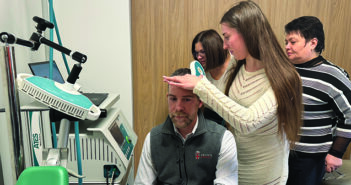Alumni of the first graduating classes define retirement on their own terms.
Forty-five years ago, Brown graduated its first class of medical students of the modern era. The early classes were vanguards, guiding the making of a medical school in the Brown tradition. They are at the forefront yet again. Now in their 60s and 70s, greater numbers of those early alumni are transitioning into retired life.
Retirement can be especially challenging to physicians. According to a study published in the Canadian Medical Association Journal, doctors still worry about their patients, even after they retire. Beyond financial reasons, physicians who delay retirement do so because of concern for their patients, lack of interests outside of medicine, and fear of losing their identities.
Brown’s first graduates have faced all of these things, and have found different ways to forge new paths in retired life. From editing medical journals to helping universities get accreditation to birthing goats, medical alumni are entering their golden years in personal—and busy—style.
“Everybody needs a family doctor right now.”

Bob and Liz George. Photography: Ryan Smith
While Robert George ’73 MD’77, P’02, P’02, and Elizabeth Ruedisueli George ’73 MD’77, P’02, P’02, went to Brown together, they met long before that: in middle school. “We started dating in high school our senior year. It turned out we had both applied to Brown,” Bob says. “As undergraduates we were both accepted into the new PLME and went from there.”
“Went from there” was into 38 years as family physicians in the small town of Mercersburg, PA. The couple retired from that practice two years ago.
“Retired,” though, is a loose term. Bob still sees patients five to six days a month, traveling to different medical offices to do so “because everybody needs a family doctor right now,” he says. Physicians retired from full-time practice are filling in and will most likely continue to do so: according to the Association of American Medical Colleges, the US will see a shortage of almost 122,000 physicians by 2032; about half will be in primary care.
Liz has focused her work on something she started while she was still working full time: Healthy Eating Adventures, a community-based, 28-day program to support people in learning a whole foods, plant-based lifestyle. “Participants are inspired to eat this way when they hear about the science behind the health benefits of plant-based eating,” she says. Coaches, pre- and postlab work, shopping trips, cooking demos, and weekly “share and learn” potlucks create an atmosphere of support and “adventure” in which to change lifelong habits.
She started the program in 2010 after the alarming news that, in America, current generations will not live longer lives than their parents. According to recent statistics from the Centers for Disease Control and Prevention, life expectancy in the US fell from 78.9 years in 2014 to 78.6 years in 2017.
Liz also had seen the rise of life-threatening illnesses, like diabetes and heart disease, in her practice, and wanted to do something about it. “These are lifestyle-based diseases,” she says. Healthy Eating Adventures is part of her nonprofit, Mercersburg Area Council for Wellness (MACWell), which is creating “a groundswell of community commitment to making the area a place that inspires its population to live well.” Programs include increasing walkability and bikeabilty, revitalizing the local stream, and building a streamside trail. The work put into Healthy Eating Adventures also comes from changes Liz saw in the doctor/patient relationship, which she says played a role in her retiring before she was truly ready. “I felt that the pressure in practice was to spend less time with your patients, whereas they should have been getting more time to learn about healthy habits,” she says.
Despite still being involved in their community, Bob says the relationship is different now, and it’s taken some getting used to. “It was very hard to leave patients behind,” he says. “We practiced in a small town, so we knew almost everybody and everybody knew us.”
How their retirement will evolve is a story untold. It does include travel, with a bike/barge trip from Amsterdam to Bruges, and recent trips to New Zealand and Antarctica with the Brown alumni group. As Bob says, “We’re still in the process of figuring out what retirement looks like.”
“Clearly Mom and Dad don’t understand the concept of retirement.”

Bob Parker
Like the Georges, Robert Parker ’73 MD’76 and Margaret Parker ’73 MD’77 went to medical school together, though separately at first. They met in freshman year biology at Brown, but Margaret went to Tufts for medical school while Bob stayed in Providence.
That arrangement of being in two cities, even ones not that far apart, wasn’t working out. So they did something that they hadn’t planned on doing until after they graduated—something that in the 1970s would give Margaret a rational explanation for transferring, though: they got married.
“Transferring after one year of medical school was not typical,” she says. “Saying I was doing it because we were getting married worked.”

Margaret Parker
They went on to work at the National Institutes of Health for more than a decade: Bob as a fellow and then senior investigator in pediatric hematology; and Margaret as the head of the Critical Care Section of the Critical Care Medicine Department. When she decided she wanted a more clinical position, they both took jobs at Stony Brook University in New York. At the time, Stony Brook had no division for pediatric hematology/oncology nor a division of pediatric critical care, so they started both. Though she trained in internal medicine, “Pediatrics is where I always belonged,” Margaret says. “I stayed there for the next 27 years.” In 2018, they retired, she as director of pediatric critical care at Stony Brook. Bob had stepped down as director of hematology/oncology about six months before retiring.
A lot of their immediate post-work time was taken up by a big change that’s typical for retirees: they moved. But not to a sunshine state. They relocated to the eastern shore of Maryland, into a house that had belonged to Bob’s father, who himself had recently moved to New Hampshire. “The initial transition stuff was all around moving: getting organized to move, getting moved, all that sort of stuff,” Margaret says. “That sucked up some of our time and energy.”
Margaret had made “noises about retiring first,” Bob says. “We have four kids, and they figured Margaret would be fine with retirement, but I would flunk retirement, and they were taking bets on how long it would take me to find something back in medicine to do.”
Not long for either of them, because they carried nonclinical roles into retirement. Margaret is the associate editor for both Critical Care Medicine and Pediatric Critical Care Medicine, and Bob is on the editorial board of both. They’re part of the Pediatric Acute Lung Injury and Sepsis Investigators (PALISI) Network, which studies critical care issues in critically ill children, and have traveled to Vancouver and Montreal to attend PALISI meetings. So far, focusing on the academic side without the clinical has worked for them. “You don’t have the aggravation of all the regulation and paper and billing,” Bob says.
When they visited one of their children, they were both working on their respective editorial duties. “Clearly Mom and Dad don’t understand the concept of retirement,” they were told.
Going into retirement is “like changing your job,” Bob says. And while there’s a lot of reasons to retire from practice, “leaving medicine in and of itself as the sole reason is not a good idea because then you’re retired and you have all this time on your hands. What the hell are you going to do?”
“Physicians by our very nature want to be productive and want to feel wanted and needed. It’s part of our ego structure,” he adds. “So you have to have something that you’re moving into, not just that you’re moving away from medicine.”
“Time flies. You don’t want to waste it.”

Nora Burgess. Photography: Timothy Archibald
When Nora Burgess ’74 MD’77 retired, the first thing she did was stop. “In all candor, I have to say I rested. I took six months and made no commitments,” she says. She had been a cardiothoracic surgeon at Kaiser Permanente in San Francisco, and wrapped up her working life as the medical group CFO and an assistant physician-in-chief.
“I had to get used to the fact that when the phone rang, it was not always a problem, which had been my experience for the last 40 years,” she says. “Being able to sleep at night and not have to worry about how someone was doing and wondering if I should go in and check on them—it took me six months to be reoriented from that point of view.”
Burgess tried new things. That included volunteering at Toluma Farms & Tomales Farmstead Creamery, a goat and sheep dairy in Marin County, CA. “I wanted to be outside and do something totally different,” she says.
One of her first assignments was mucking out stalls and putting in new alfalfa for the nanny goats and their kids. She worked during lambing and kidding season, which meant she had to “go up into the hills and find new moms and newborn lambs and kids,” she says, so they could bring the babies down to the barn.
“That was a lot of fun. There’s nothing better than a newborn goat,” Burgess says.
She also made a wish list by asking herself: “If I was 95, what would I look back and see that I have done?”
So she’s taken art lessons, everything from pastels to pine needle baskets. She and her husband have traveled—a lot: to the Aleutian Islands, the Kamchatka Peninsula, to Myanmar along the Irrawaddy River and Cambodia, Moscow to St. Petersburg via the Volga Baltic Waterway, the Northwest Passage from Greenland to Nome via Ballot Strait to Peel Sound, Patagonia and the Chilean fjords, Iceland, Africa, and the Galapagos.
They’re doing the kind of “remote travel you want to do when you’re healthy and on the younger end of retirement,” she says.
With her 96-year-old father, she wrote a book for their family so that his story, along with genealogy and photos, are in one place for them to share and enjoy.
She did some volunteer mission work in the Dominican Republic and Guatemala, but her tertiary care skills didn’t translate as well as more primary care-oriented specialties.
Burgess remembers a piece of advice she once got from a senior cardiothoracic surgeon mentor. He told her that “you don’t have to do the same thing forever,” she says. “He was giving me permission to look at things with a blank page, imagining what new skills and experiences might be interesting.”
For the first time, “I felt I had the luxury of managing my own time, which is pretty exhilarating. I could do anything.” Retirement is “figuring out what that means for you,” she adds. “Time flies. You don’t want to waste it.”
“It’s very difficult to come home and consume oxygen.”

Glenn Mitchell
Glenn Mitchell ’67 SCM’69 MD’75 RES’77, MPH, followed an unusual path to medical school. He wasn’t pre-med and didn’t take the MCATs. He got his undergraduate degree at Brown and was in his first year of graduate school toward what he hoped would be a PhD in engineering. “After losing my grad student deferral when the rules for the Vietnam draft lottery were announced, I searched for options other than being drafted,” he says. With the help of faculty connections, he worked in weapons development under contracts from the Department of Defense and other government agencies.
His experiences during those years led him to abandon the PhD in engineering and decide to become a physician instead. “The graduate school dean said he could change my concentration from engineering to medicine,” Mitchell says. A few months later the Medical School was established, and he was grandfathered into the first class.
Mitchell’s career didn’t take a straight line from there, either. In the 1980s, he taught at Brown and became chief of emergency medicine at Pawtucket Memorial Hospital. He also tried to establish an emergency medicine program at Brown, though it didn’t take at the time.
So he joined the Army at 37 years old, where he stayed for more than 20 years. In that time, he became a flight surgeon, commander of the US Army Aeromedical Center, then deputy commander of the Eisenhower Army Medical Center, and command surgeon of the US Army Southern Command, which was responsible for all US military interactions in 31 countries in South and Central America and the Caribbean. In his last two roles with the military, he served as chief of clinical operations for the US Army Medical Command and commander of the William Beaumont Army Medical Center. He retired from the Army in 2005.
But he wasn’t done yet. He went back to being a full-time emergency physician and director and chief of ambulatory care at the Indian Health Service for two years (and learned to speak some Navajo). At the same time his wife, Jane Hathaway Mitchell, set up the first inpatient adolescent and psychiatric treatment unit for the Navajo tribe, “and did it with Western medicine mixed with shamans and sweat lodges and culturally
appropriate methods,” he says.
Mitchell went on to serve as the chief medical officer and vice president of clinical safety of Mercy Health System in St. Louis for five years, building their informatics facility and setting up their electronic health records system.
After leaving Mercy, he thought that’s when he would finally retire. “I was in my 60s and I thought, ‘OK, that’s enough for me.’”
For two years, he did just that, with some consulting mixed in. But he got antsy with at-home life. So he became the founding chair and professor of medical informatics at the Harrisburg University of Science
and Technology in Pennsylvania. He was recently promoted to vice provost of the university.
“When you’re dealing with being retired after being sort of a semi-type A physician forever and going around the world and interacting with the health care system, it’s very difficult to come home and consume oxygen,” he says. “It turned out to be too hard for me. I needed to work, and luckily I have a spouse who understands that.” Jane has retired after a career in psychology and nonprofit work with the Red Cross.
Now 73 years old, Mitchell says he doesn’t know what the future holds. After all, even though he is retired from the Army, he still carries the rank of colonel. “I could get called back to active duty,” he says. “I think I would go right after they call my dog.”




